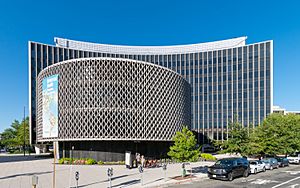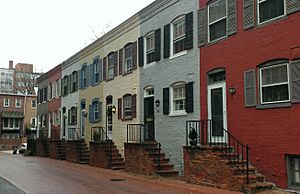Foggy Bottom facts for kids
Quick facts for kids
Foggy Bottom
|
|
|---|---|
|
Neighborhood of Washington, D.C.
|
|
|
Top: Corcoran School of Art (left) and U.S. Department of Interior (right); middle: Monroe-Adams House (left), George Washington University (center), The Octagon House (right); bottom: American Red Cross (left), and Foggy Bottom–GWU station (right)
|
|
 |
|
| Country | United States |
| District | Washington, D.C. |
| Quadrant | Northwest |
| Ward | 2 |
Foggy Bottom is a neighborhood in Washington, D.C., United States. It's located in the northwest part of the city, near important places like the White House and the Potomac River. It is also close to Georgetown and the National Mall.
This area is well-known because it's home to the United States Department of State, which is like the country's main office for dealing with other nations. Because of this, people sometimes use "Foggy Bottom" as a shortcut to talk about the State Department. Many other important organizations are here too, like the Federal Reserve (which manages the country's money) and the World Bank. A big part of the neighborhood is taken up by George Washington University.
Within Foggy Bottom, there's a special Historic District. It has older row houses and small streets called alleys. These homes date back to the 1870s. They were once home to working-class families from Ireland, Germany, and African American communities between 1860 and 1915.
Contents
History of Foggy Bottom

Foggy Bottom was one of the first places in what is now Washington, D.C., where Europeans settled. A German settler named Jacob Funk divided up about 130 acres of land here in 1763. This was near where the Potomac River and Rock Creek meet. The settlement was officially called Hamburgh, but people often called it Funkstown.
In 1765, more German settlers helped establish the town of Hamburg. This area is now between 24th and 18th NW Street. Jacob Funk also set aside land for German-speaking churches in 1768. One of these, the Concordia German Evangelical Church, was founded in 1833. Today, it is the United Church and is the oldest religious community still in Foggy Bottom.
Why is it Called Foggy Bottom?
By the 1800s, Foggy Bottom became a place where many workers lived. They worked at nearby factories like breweries, glass plants, and city gas works. These factories might be why the neighborhood got its name. The "fog" could have been the smoke and steam coming from these industries.
Discoveries and Development
In 1877, something amazing happened in Foggy Bottom. The two moons of Mars, Phobos and Deimos, were discovered from the old United States Naval Observatory. This observatory was located here until 1893.
In 1912, George Washington University moved its main campus to Foggy Bottom. This campus covers about 42 acres of the neighborhood.
The Old Brewery and Kennedy Center
The neighborhood was also home to the Christian Heurich Brewing Company. This brewery made popular local beers. It stopped making beer in 1956. Later, in 1961–1962, the brewery buildings were torn down. In their place, the John F. Kennedy Center for the Performing Arts was built. The Heurich family donated some of the brewery land to the Kennedy Center.
Life in the Alleys
The design of Washington D.C. included open spaces in the middle of city blocks. These spaces became alleys. In the 1860s, many Irish and German immigrants moved to Foggy Bottom to work in the factories. There weren't enough houses, so many people moved into these alleys. After the Civil War, more people, including newly freed Black Americans, also moved to the alleys.
Living conditions in the alleys could be very tough. Many homes were crowded, and people often shared or lacked proper toilets. The government tried to improve things by demolishing some alley homes in the early 1900s. They wanted to reduce overcrowding and improve health.
In the 1920s, a law called Prohibition made it illegal to sell alcohol. This affected many people in Foggy Bottom who worked in breweries. Some people started selling illegal alcohol in the alleys. In 1934, the government created the Alley Dwelling Authority (ADA). The ADA's job was to improve the alleys in Washington D.C. They could tear down or fix up buildings that were in poor condition.
The ADA worked to create better living spaces. They aimed for larger homes with improved conditions. This allowed owners to charge more rent. Over time, the living conditions in Foggy Bottom's alleys got better.
West Station Works and the Watergate Complex
In 1856, a gas plant called West Station Works was built in Foggy Bottom. It was located near the Potomac River, which made it easy to bring in coal by boat. This plant brought many workers to the area.
By 1860, a large number of unskilled workers lived in Foggy Bottom. This led to more buildings and growth in the neighborhood. In 1948, the land where the gas plant stood was bought by the Watergate Project. The plant was taken down, and the famous Watergate complex was built there. Today, there's no sign of the old gas plant, but its history is remembered.
Points of Interest in Foggy Bottom
|
Foggy Bottom Historic District
|
|

Aerial view of Foggy Bottom. The Watergate Complex is in the foreground.
|
|
| Location | Bounded by 17th St., Rock Creek Parkway, Constitution Ave., Pennsylvania Ave., NW, Washington, D.C. |
|---|---|
| NRHP reference No. | 87001269 |
| Added to NRHP | October 14, 1987 |
Foggy Bottom has many interesting places to visit. The Kennedy Center for the Performing Arts is a major spot for concerts and shows. It's home to the National Symphony Orchestra.
The Watergate complex is also here. This building is famous because of the Watergate scandal. This event led to President Richard Nixon's resignation in the 1970s.
George Washington University takes up a large part of the neighborhood. It has many historic old homes and apartment buildings. The historic part of Foggy Bottom is protected and listed on the National Register of Historic Places.
Other important places include the Simon Bolivar Memorial on Virginia Avenue. The university's Lisner Auditorium and Smith Center often host big concerts. DAR Constitution Hall is another popular venue for events.
Government and International Offices
The southern part of Foggy Bottom has many important government offices. The United States Department of State headquarters, called the Harry S. Truman Building, is here. The Main Interior Building (for the United States Department of the Interior), the Bureau of Indian Affairs headquarters, and the Federal Reserve Board buildings are all nearby.
The Eisenhower Executive Office Building is also in Foggy Bottom. It houses offices for the President and Vice President of the United States. The White House is just outside the neighborhood.
Many international and American organizations have their headquarters in Foggy Bottom. These include the World Bank, the International Monetary Fund, the American Red Cross National Headquarters, and the Pan American Health Organization. The embassies of Mexico and Spain are also located on Pennsylvania Avenue in Foggy Bottom.
Geography of Foggy Bottom

Foggy Bottom is bordered by 17th Street NW to the east. To the west, it's next to the Potomac River and Rock Creek Parkway. Constitution Avenue and the National Mall are to the south. Pennsylvania Avenue NW is to the north.
The name "Foggy Bottom" likely comes from its location. It's a low-lying, marshy area near the river. This made it prone to thick fog. Later, smoke from factories also contributed to the "fog." The United States Department of State got the nickname "Foggy Bottom" when its main office moved there in 1947.
People of Foggy Bottom

The people living in Foggy Bottom have changed over time. In the past, many working-class families lived here, including Irish, German, and African American communities. As the neighborhood developed, especially with new buildings and university growth, the population changed.
Today, Foggy Bottom is mostly white. It also has a large number of university students who live off-campus. As of the 2010 United States Census, there were 14,642 residents. About 78.3% of them were white. The student population greatly affects the age and income of the people living here.
Getting Around Foggy Bottom
The Foggy Bottom neighborhood is easy to get to using public transportation:
- The Foggy Bottom – GWU Washington Metro station serves the Blue, Orange, and Silver Lines.
- Many Metrobus routes also run through the area.
- You can also find rentable bikes and electric scooters easily.
Education in Foggy Bottom

George Washington University (GWU) is a major university located right in Foggy Bottom.
For public schools, children in Foggy Bottom attend schools that are part of the District of Columbia Public Schools (DCPS) system. The local elementary and middle school is School Without Walls at Francis-Stevens. For high school, students are zoned for Cardozo Education Campus. DCPS also runs School Without Walls, which is a special magnet high school located on the GWU campus.
Images for kids
-
In 1877, the moons of Mars were discovered at the Old Naval Observatory on Potomac Hill.
-
The headquarters of the World Bank
-
The Eccles Building, the headquarters of the Federal Reserve
-
The headquarters of the International Monetary Fund
-
The Harry S. Truman Building, the headquarters of the U.S. Department of State
See also
 In Spanish: Foggy Bottom para niños
In Spanish: Foggy Bottom para niños
















